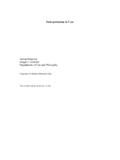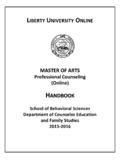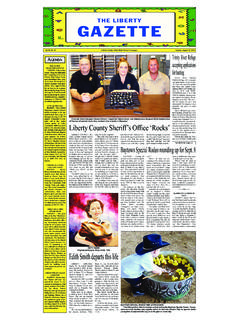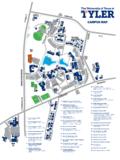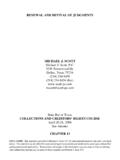Transcription of Harm and Offence in Mill's Conception of Liberty
1 Jorge Menezes Oliveira Faculty of Law university of Oxford Harm and Offence in Mill s Conception of Liberty This paper discusses John Stuart Mill s approach to offensive behaviour, and its relation with harmful conduct and the Liberty principle, abstracting as much as possible from the difficulties of his general utilitarian morality and its controversial relation with the Liberty principle. The Liberty or Harm Principle Mill proclaims in the first sentence of his 1859 book On Liberty that [t]he subject of this Essay Civil, or Social Liberty : the nature and limits of the power which can be legitimately exercised by society over the individual . As revealed by the main titles of its chapters, Mill draws together and correlates Liberty of thought and discussion , individuality, as one of the elements of well-being , and the limits to the authority of society over the individual.
2 Mill describes it in his Autobiography as a kind of philosophic textbook of a single : the importance, to man and society, of a large variety in types of character, and of giving full freedom to human nature to expand itself in innumerable and conflicting directions. (p 215) The essay is particularly renowned by asserting one very simple principle , according to which harm to others is the sole justification for coercive intervention. In his own words, That principle is, that the sole end for which mankind are warranted, individually or collectively, in interfering with the Liberty of action of any of their number, is self-protection. That the only purpose for which power can be rightfully exercised Jorge Menezes Oliveira Faculty of Law university of Oxford 2over any member of a civilized community, against his will, is to prevent harm to others. His own good, either physical or moral, is not a sufficient warrant.
3 He cannot rightfully be compelled to do or forbear because it will be better for him to do so, because it will make him happier, because, in the opinions of others, to do so would be wise, or even right. (LI10) Later in the book he puts forward the two maxims of his essay: The maxims are, first, that the individual is not accountable to society for his actions, in so far as these concern the interests of no person but himself. Advice, instruction, persuasion, and avoidance by other people, if thought necessary by them for their own good, are the only measures by which society can justifiably express its dislike or disapprobation of his conduct. Secondly, that for such actions as are prejudicial to the interests of others, the individual is accountable, and may be subjected either to social or to legal punishments, if society is of opinion that the one or the other is requisite for its protection. (LV2) The first maxim is the Liberty principle, the second has been termed the social authority principle.
4 He tells us that these two maxims together form the entire doctrine of this Essay (LV1). Mill aims to establish a principle that isolates an area of Liberty within which people are uninterfered with in developing their individuality through free choice and experiments in living. It seeks to bar intrusive action justified on paternalistic or merely moralistic grounds [ because it will be better for him to do so, because it will make him happier, because, in the opinions of others, to do so would be wise, or even right .] A main feature of Mill s defence of Liberty is its force, its unbending character. Where the Liberty principle applies, the Liberty of individuals should be absolute and indefeasible, a principle entitled to govern absolutely the dealings of society with the individual in the way of compulsion and control . He says repeatedly that their Liberty is by right absolute with respect to matters said to be harmless to other people, that individuals enjoy absolute Liberty to choose Jorge Menezes Oliveira Faculty of Law university of Oxford 3as they please among certain purely self-regarding acts.
5 The reasonableness of attributing categorical force to a principle of Liberty is very much dependent on its scope, which is of a very limited range .1 It does not state the necessary and sufficient conditions for justified coercion. Mill does certainly not pretend that the principle is a sufficient condition for legitimate use of coercion against individuals, it specifies only a necessary condition: Liberty of action may be restrained inasmuch as it is harmful to others. It tells us when we may restrict Liberty , not when we ought to do so. He is willing to give absolute shelter to the self-regarding realm the range of actions not harmful to others not to provide a complete picture of the liberties that individuals ought to enjoy. Individual Liberty is not in practice confined to the principle of Liberty , that is, to the self-regarding domain. Freedom should be protected (i) whenever action is harmless to others, as well as (ii) whenever it is inexpedient to control it, although interference could be legitimately considered from the viewpoint of the Liberty principle.
6 Therefore, the full conditions of justified coercion are two-fold: the act must be harmful to others, and it must be expedient to constrain its practice. The Liberty principle per se does not cover the expedient scope of Liberty , it is not about determining the full range of individual Liberty . It is not about the right of property, to set up a business, to sell goods, to vote, to a fair trial, to a fair distribution of resources, or even a defence of a range of basic liberties as the ones advanced by Rawls. It is about a distinctive class of equal liberties of thought, expression and action in every single fashion not harmful to other people, a defence of a walled domain sealed off against coercive or oppressive interference within which individuals have an indefeasible right to a definite and unqualified control over the way they think, 1 Dworkin, 1974, p 2.
7 Jorge Menezes Oliveira Faculty of Law university of Oxford 4express their thoughts and feelings, and act, in order to promote the cultivation of their individuality through experiments in living. The principle states a sufficient condition for legitimate protection of Liberty : the individual ought to be free from societal interference if her action does not harm others. Of course, Mill was obviously aware of the fact that no democratically developed society could be satisfied with such a confined scope of Liberty . Immoral and Other-Regarding Conduct The notions of morality, harm prevention, and other-regarding conduct are fundamentally intertwined in Mill s doctrine. Immoral or wrong conduct is that which affects or interferes (in a certain manner) with certain interests of others, that which is harmful to Therefore, the phrase harmless wrongdoing finds no place in Mill s doctrine as it is a contradiction in terms: purely self-regarding acts, harmless to other people, are beyond morality.
8 Saying that an action is wrong is committing oneself to the view that it is socially harmful, and calling the aid of public opinion or legal coercion in stopping that To Mill the scope and subject matter of morality is that of enforceable obligations about harm prevention. Only morality generates obligations excellence and prudence do not. Moral obligation is about those things that people are bound to do , and whose infringement makes them proper objects of punishment and blame. Mill states clearly that it is a part of the notion of duty that a person may rightfully be compelled to fulfil it. Duty is a thing which may be exacted from a person, as one exacts a debt, and the real 2 The harm principle states not so much that coercion is legitimate if conduct is harmful, but the broader notion that the Liberty of an action may be interfered with (coerced) if the interference prevents harm to others (Lyons, p 127).
9 3 Ryan, 1991, p 166. Jorge Menezes Oliveira Faculty of Law university of Oxford 5turning point of the distinction between morality and simple expediency is its binding nature, its enforceability, and deserving social interference and punishment (UV14). He says in this regard that We do not call anything wrong, unless we mean to imply that a person ought to be punished in some way or other for doing it; if not by law, by the opinion of his fellow-creatures; if not by opinion, by the reproaches of his own How we come by these ideas of deserving and not deserving punishment, will appear, perhaps, in the sequel; but I think there is no doubt that this distinction lies at the bottom of the notions of right and wrong (UV14) Although it is not wrong to say that this is a distinctive feature of morality, that its subject matter is that of enforceable obligations whose infringement ought to be punished, I do not think that one should believe that the Millian criterion of right (or permissible) and wrong action lies on whether an action deserves to be stopped and punished, on whether it relates to things in which we think we have a right to control him (LIV7).
10 The idea of deserving punishment is but a formal criterion of wrongness. Conduct ought to be punished because it is wrong, it is not so much the case that it is wrong because it ought to be punished. What makes an action wrong in the first place is that it is harmful. The critical and ultimate question to determine the limits of morality and of social and legal coercion, or the domain of Liberty , is primarily the question of which actions are harmful to others. 4 4 Harm, however, is not a non-moral concept, and it presupposes a substantive theory of justice understood in a broad sense, similar to the one conveyed by Rawls: a characteristic set of principles for assigning basic rights and duties and for determining what they take to be the proper distribution of the benefits and burdens of social cooperation (A Theory of Justice, p 5). For instance, to have a right against unauthorised interference with material goods that one possesses depends on, say, a just allocation of resources or a certain Conception of private property.
